by George Dyke…..
I had a chance to visit the Mullin Museum on January 16 and see the “Citroën: The Man, The Marque, The Mystique” exhibit that is on through March of this year. Peter Mullin, the founder of Mullin Consulting and other financial services, is a true automotive enthusiast. Automobile’s 2015 man of the year, Mullin is a well-known philanthropist and car collector. As chairman of the Petersen Automotive Museum, Mullin is dedicated to the preservation and exhibition of cars deemed both as works of art and history.
 Photos courtesy of Frank Barrett and George Dyke.
Photos courtesy of Frank Barrett and George Dyke.
His passion is for French automobiles, and to that end displaying them to appreciative automotive enthusiasts, in 2010 he founded the Mullin Automotive Museum located in Oxnard CA. After more than three decades worth of work, Mullin has created one of the world’s greatest collections of French vehicles, and in the past 4 years, he focused on amassing an astounding collection of 48 classic Citroëns and in particular a number of rare Henri Chapron produced custom bodied versions of the iconic DS.
Most notable is a DS Majesty sedan with reverse opening rear doors. It was built for a Swiss gentleman constrained to a wheelchair who needed easy access to the rear of the passenger compartment.
See a full photo Gallery of the exhibit here: https://flic.kr/s/aHskAEgci4
Fortunately, my friend John Long, who works close by the Mullin Musem, manufacturing modernized Bowlus Road Chief travel trailers, had a few hours to spare and accompanied me on my visit.
There were 8 other people on the tour along with our Mullin exhibit guide Dave who just happened to be Canadian, and from Hamilton (near Toronto, ON). Dave is retired from BMW Canada and now works giving tours at the Mullin Museum. As it turns out he remembered John since one of John’s former businesses/hobbies was Escargot Motors. In the late 1980’s and early 1990’s John and his brother Greg imported 2CV’s into Canada and as part of their means to acquire customers had a sales exhibit at the Toronto Auto Show. Dave recalled Escargot’s presence at the show while working for BMW at the time, and how their 2CV stood out from the rest of the automotive offerings at the time. It was (and still is) a vehicle that is the antithesis of everything else! (You can read about the history of Escargot here: https://citroenvie.com/how-new-2cvs-were-aged-for-sale-in-north-america/. And Citroënvie members, be sure to check our video shot during the Toronto Auto Show of John doing an introduction to the press while standing in a 2CV. That video is in our archives section under 2CV/Escargot Motors).
The variety of Citroëns displayed at the Mullin Museum was impressive as was the means used to revive the theme of past Citroën exhibits over the 1920’s, 30’s and 50’s, replete with hanging Citroën banners that showed the evolution of the Citroën Chevrons logo from inception to present day.
Upon entering the exhibit you first see a full-size Flying D, a recreation of the iconic art piece sculpture enclosing the front wheels with a smooth underside that was produced in various forms for exhibits during the time the D model was in production.
For this one, a 1967 ID19 was mounted on a support at the rear so that it appeared to be a floating rocket. Quite an impressive start to a display that is the largest collection of Citroëns ever to be shown in North America and one of the most impressive exhibits to date worldwide!
One thing that really impressed me was the oldest Citroën on display, an unrestored 1919 Type A (the first mass-produced car in Europe).
It had electric lights in an era where gas lamps were still the norm. And the headlights had a bulb arrangement with the main bulb in the center and “ville light” in the reflector off to the side. An almost identical configuration was used in the 2CV right up to the end of production in 1990, and in many other Citroën models through the years!
Beyond the cars, there were items gleaned from Citroën’s archives, like a drawing by André Lefebvre showing a proposed next generation rather boxy sedan based on the Traction. (He began his career as an aviation engineer working for Voisin, then later for Renault and Citroën where he was the chief engineer for the Traction Avant).
Lefebvre is noted for creating the Voisin C6 Laboratorie, which was a race car prepared for the 1923 French Grand Prix of which a functional full-size reproduction of that car is also on display at the museum.
Speaking of the Traction Avant, also in the exhibit was Peter Mullin’s first Citroën acquisition, a 1935 7C Traction Avant Cabriolet.
Also on display, a very rare 1937 Challenger (Traction Avant) sedan sold by Challenger Motors in Los Angeles. This one had a headlamp with a top mounted running light that has never seen on any other Traction.
The supercharged SM race car and customized SM tow vehicle built by Jerry Hathaway were on display. The last time I recall seeing them was at ICCCR in Amherst MA in 2002 when Jerry drove them from California to the meeting. He fired up the SM racer a few times during the ICCCR event with the resulting roar of an F18 fighter jet.
One car that Mr. Mullin does not own that is on display is a Facel Vega II convertible (the only convertible of that model to exist) that belongs to Manny Motashaw. The rationale for it being displayed among the Citroëns is that that Mr. Facel, Jean Daninos, designed the Traction Avant convertible!
A few Bugatti automobiles were left on display including seven unrestored “barn finds” that Mullin purchased from the Schlumpf Reserve Collection. And then there was the famous unrestored Type 22 Brescia that was lost in Lake Maggiore, Italy for over 70 years and hence nicknamed the “Lady of the Lake”. René Dreyfus was said to be the car’s owner at one point, losing it to a Swiss playboy in a drunken poker game. The 40 horsepower, 100 MPH-capable marvel was then taken back to Switzerland, where the story becomes a bit convoluted. There are multiple versions of the story explaining how the car got to the bottom of the lake. However, all of them claim that the car’s new owner was unable to pay the import taxes on the vehicle. Due to this, the Brescia was sunk in the lake, where it sat for decades. In 2009, a local diving club exhumed what remained and placed it in a charity auction where Mullin placed a top bid of $280,000 to beat out a potential buyer wanting to do a full restoration to the vehicle. Today it sits on display, dry but in the condition, it was found, in a special humidity controlled section of the museum.
If you have not seen the Mullin Citroën exhibit, check out the article we first did about its opening here: https://citroenvie.com/mullin-museum-exhibit-to-be-citroen-the-man-the-marque-the-mystique/. And in this article is a link to an excellent video produced specifically for the Citroën exhibit that discussed not only the cars’ features, but talks about the vision and innovation and marketing prowess of André Citroën, and the engineering in these vehicles makes them so unique and influential in automotive history.
When the Citroën exhibit does not occupy the museum, it is normally populated with rare French vintage car marques the likes of Bugatti, Delage and Talbot Logo. Two years ago I paid a visit when those were on display. You can read about that here: https://citroenvie.com/mullin-automotive-museum-to-celebrate-citroens/.
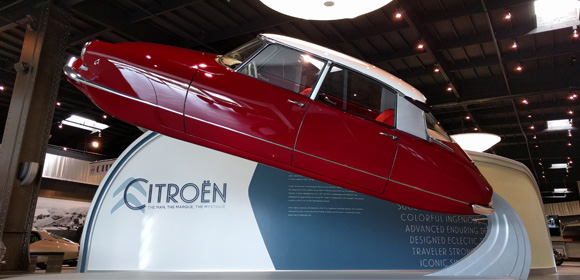
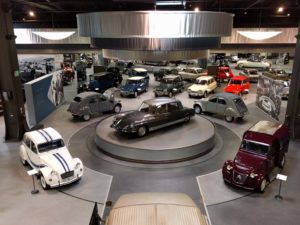
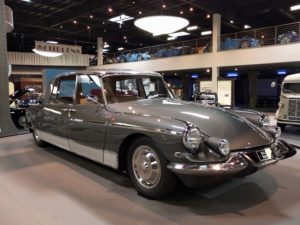

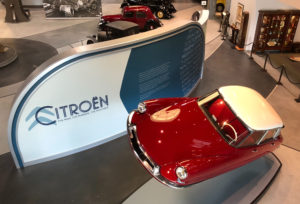
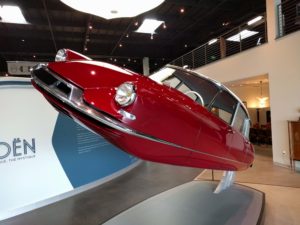

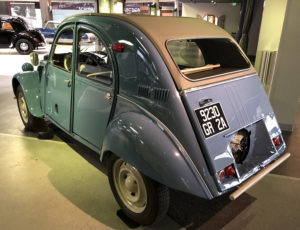
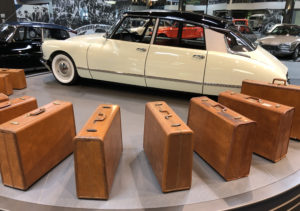
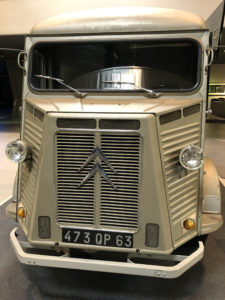



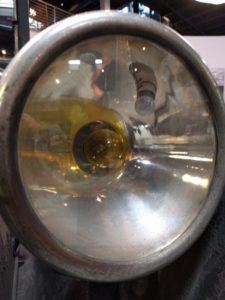
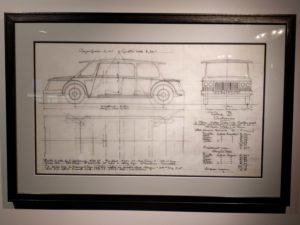

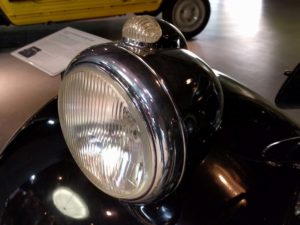

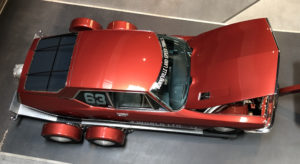
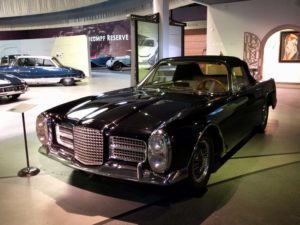


Thanks for your “guide/review” for the Mullin exhibit. I’m looking forward to seeing it in March before it gets taken down/moved. If not to redundant, I’ll post my “review” when I get back.
Cheers
Gary
The “flying D” in the Mullin museum has or had a replica in southern New Jersey. In the 1970s when I was stationed in Philadelphia, I was on the White Horse Pike in NJ and there it was, on a pole with covered over wheel wells. Painted white as I recall. The White Horse Pike, like the Black Horse Pike were the two original main roads out of Philly going east into NJ, built long before interstates, much like Route 13 that goes down the east coast of the US, or Highway 2 in Ontario, Canada.